New Geochemical Insights into Pre-Khorat Paleoenvironments: A Case Study of Triassic–Jurassic Reddish Sedimentary Rocks in Thailand
Abstract
1. Introduction
2. Samples and Methods
3. Results
3.1. Field Observation and Stratigraphy
3.2. Petrography
3.3. Geochemistry
3.3.1. Rock Name and Paleoclimate
3.3.2. Provenance and Environment of Deposition
3.3.3. UCC Normalized Diagrams and REE Pattern
4. Discussion
4.1. Sediment Composition and Provenance
4.2. Sedimentary Structures and Paleoenvironments
4.3. Paleoclimate and Depositional Context in the Triassic–Jurassic
4.4. Implications for Basin Evolution
5. Conclusions
Supplementary Materials
Author Contributions
Funding
Data Availability Statement
Acknowledgments
Conflicts of Interest
References
- Ward, D.E.; Bunnag, D. Stratigraphy of the Mesozoic Khorat Group in Northeastern Thailand; Department of Mineral Resources: Bangkok, Thailand, 1964; No. 6. [Google Scholar]
- Racey, A. Mesozoic red bed sequences from SE Asia and the significance of the Khorat Group of NE Thailand. In Late Palaeozoic and Mesozoic Ecosystems in SE Asia; Buffetaut, E., Cuny, G., Le Loeuff, J., Suteethorn, V., Eds.; Special Publications; Geological Society: London, UK, 2009; Volume 315, pp. 41–67. [Google Scholar] [CrossRef]
- Racey, A.; Love, M.; Canham, A.; Goodall, J.; Polachan, S.; Jones, P. Stratigraphy and reservoir potential of the Mesozoic Khorat Group, NE Thailand: Part 1: Stratigraphy and sedimentary evolution. J. Petrol. Geol. 1996, 19, 5–39. [Google Scholar] [CrossRef]
- Department of Mineral Resources (DMR). Geologic Map of Northeast Thailand; Scale 1:650,000; DMR: Bangkok, Thailand, 2023. [Google Scholar]
- Chonglakmani, C. Triassic. In The Geology of Thailand; Ridd, M.F., Barber, A.J., Crow, M.J., Eds.; Geological Society of London: London, UK, 2011. [Google Scholar]
- Singtuen, V.; Phajuy, B.; Anumart, A.; Charusiri, P.; Chawthai, N.; Heggemann, H.; Zhang, S.-H. Geochemistry and provenance of Mesozoic sandstones in Khon Kaen Geopark: Implication for tectonics of the western Khorat Plateau of Thailand. PLoS ONE 2023, 18, e0284974. [Google Scholar] [CrossRef]
- Yu, M.; Dick, J.M.; Feng, C.Y.; Li, B.; Wang, H. The tectonic evolution of the East Kunlun Orogen, northern Tibetan Plateau: A critical review with an integrated geodynamic model. J. Asian Earth Sci. 2020, 191, 104168. [Google Scholar] [CrossRef]
- Xiong, F.H.; Ma, C.Q.; Jiang, H.A.; Liu, B.; Huang, J. Geochronology and geochemistry of Middle Devonian mafic dykes in the East Kunlun Orogenic Belt, northern Tibetan Plateau: Implications for the transition from Prototethys to Paleotethys orogeny. Geochemistry 2014, 74, 225–235. [Google Scholar] [CrossRef]
- Li, S.; Zhao, S.; Liu, X.; Cao, H.; Yu, S.; Li, X.; Somerville, I.; Yu, S.; Suo, Y. Closure of the Proto Tethys Ocean and Early Paleozoic amalgamation of microcontinental blocks in East Asia. Earth Sci. Rev. 2018, 186, 37–75. [Google Scholar] [CrossRef]
- Xin, W.; Sun, F.-Y.; Li, L.; Yan, J.-M.; Zhang, Y.-T.; Wang, Y.-C.; Shen, T.-S.; Yang, Y.-J. The Wulonggou metaluminous A2-type granites in the eastern Kunlun Orogenic Belt, NW China: Rejuvenation of subduction-related felsic crust and implications for post collision extension. Lithos 2018, 312–313, 108–127. [Google Scholar] [CrossRef]
- Li, R.; Pei, X.; Li, Z.; Pei, L.; Chen, G.; Liu, Z.; Chen, Y.; Liu, C.; Wang, M.; Zhang, M. Paleo Tethyan Ocean evolution and Indosinian orogenesis in the East Kunlun Orogen, northern Tibetan Plateau. Minerals 2022, 12, 1590. [Google Scholar] [CrossRef]
- Dew, R.E.; Collins, A.S.; Glorie, S.; Morley, C.K.; Blades, M.L.; Nachtergaele, S.; King, R.; Foden, J.; De Grave, J.; Kanjanapayont, P.; et al. Probing into Thailand’s basement: New insights from U–Pb geochronology, Sr–Nd–Pb and Lu–Hf isotopic systems in granitoids. Lithos 2018, 320–321, 332–354. [Google Scholar] [CrossRef]
- Hara, H.; Tokiwa, T.; Kurihara, T.; Charoentitirat, T.; Sardsud, A. Revisiting the tectonic evolution of the Triassic Paleo Tethys convergence zone in northern Thailand, inferred from detrital zircon U–Pb ages. Geol. Mag. 2021, 158, 905–929. [Google Scholar] [CrossRef]
- Hara, H.; Kurihara, T.; Charoentitirat, T.; Sardsud, A. Sandstone provenance and U–Pb ages of detrital zircons from Permian–Triassic forearc sediments within the Sukhothai Arc, northern Thailand: Record of volcanic-arc evolution in response to Paleo Tethys subduction. J. Asian Earth Sci. 2017, 146, 30–41. [Google Scholar] [CrossRef]
- Charusiri, P.; Clark, A.H.; Farrar, E.; Archibald, D.; Charusiri, B. Granite belts in Thailand: Evidence from the 40Ar/39Ar geochronological and geological syntheses. J. Southeast Asian Earth Sci. 1993, 8, 127–136. [Google Scholar] [CrossRef]
- Arboit, F.; Collins, A.S.; Morley, C.K.; King, R.; Amrouch, K. Detrital zircon analysis of the southwest Indochina terrane, central Thailand: Unravelling the Indosinian orogeny. GSA Bull. 2016, 128, 1024–1043. [Google Scholar] [CrossRef]
- Meesook, A. Cretaceous environments of northeastern Thailand. In Cretaceous Environments of Asia; Okada, H., Mateer, N.J., Eds.; Elsevier Science B.V.: Amsterdam, The Netherlands, 2000; pp. 207–223. [Google Scholar]
- Meesook, A.; Suteethorn, V.; Chaodumrong, P.; Teerarungsigul, N.; Sardsud, A.; Wongprayoon, T. Mesozoic rocks of Thailand. In Proceedings of the Symposium on Geology of Thailand; Mantajit, N., Ed.; Department of Mineral Resources: Bangkok, Thailand, 2002; pp. 82–94. [Google Scholar]
- Singtuen, V.; Jansamut, S.; Wongadsapaiboon, T.; Pratchayakup, P.; Phajuy, B.; Wongchan, S. Geological characteristics of ancient Sīma stone heritage in Khon Kaen Geopark, Northeastern Thailand. npj Herit. Sci. 2025, 13, 213. [Google Scholar] [CrossRef]
- Singtuen, V.; Vivitkul, N.; Junjuer, T. Geoeducational assessments in Khon Kaen National Geopark, Thailand: Implication for geoconservation and geotourism development. Heliyon. 2022, 8, e12464. [Google Scholar] [CrossRef]
- Racey, A.; Goodall, J. Palynology and stratigraphy of the Mesozoic Khorat Group red bed sequences from Thailand. In Late Palaeozoic and Mesozoic Continental Ecosystems in SE Asia; Buffetaut, E., Cuny, G., Le Loeuff, J., Suteethorn, V., Eds.; Special Publications; Geological Society: London, UK, 2009; Volume 315, pp. 69–83. [Google Scholar] [CrossRef]
- Booth, J.; Sattayarak, N. Subsurface Carboniferous–Cretaceous geology of Northeast Thailand. In The Geology of Thailand; Ridd, M.F., Barber, A.J., Crow, M.J., Eds.; Geological Society of London: London, UK, 2011. [Google Scholar]
- Meesook, A.; Saengsrichan, W. Jurassic. In The Geology of Thailand; Ridd, M.F., Barber, A.J., Crow, M.J., Eds.; Geological Society of London: London, UK, 2011. [Google Scholar]
- Hanta, R.; Sekiya, T.; Shibata, M.; Naksri, W.; Tucker, R.T. Hatchling and early juvenile of early sauropod from the Early–Middle Jurassic Nam Phong Formation, Chaiyaphum Province, Northeastern Thailand. Palaeontol. Res. 2023, 28, 222–239. [Google Scholar] [CrossRef]
- Pettijohn, F.J.; Potter, P.E.; Siever, R. Sand and Sandstone. Soil Sci. 1974, 117, 130. [Google Scholar] [CrossRef]
- Dickinson, W.R.; Beard, L.S.; Brakenridge, G.R.; Erjavec, J.L.; Ferguson, R.C.; Inman, K.F.; Knepp, R.A.; Lindberg, F.A.; Ryberg, P.T. Provenance of North American Phanerozoic sandstones in relation to tectonic setting. Geol. Soc. Am. Bull. 1983, 94, 222–235. [Google Scholar] [CrossRef]
- Ingersoll, R.V.; Suczek, C.A. Petrology and provenance of Neogene sand from Nicobar and Bengal Fans, DSDP Sites 211 and 218. J. Sediment. Res. 1979, 49, 1217–1228. [Google Scholar] [CrossRef]
- Dickinson, W.R.; Suczek, C.A. Plate tectonics and sandstone compositions. AAPG Bull. 1979, 63, 2164–2182. [Google Scholar] [CrossRef]
- Herron, M.M. Geochemical classification of terrigenous sands and shales from core or log data. J. Sediment. Petrol. 1988, 58, 820–829. [Google Scholar]
- Suttner, L.J.; Dutta, P.K. Alluvial sandstone composition and paleoclimate, framework mineralogy. J. Sediment. Petrol. 1986, 56, 329–345. [Google Scholar] [CrossRef]
- Bhatia, M.R.; Crook, K.A.W. Trace element characteristics of graywackes and tectonic setting discrimination of sedimentary basins. Contrib. Mineral. Petrol. 1986, 92, 181–193. [Google Scholar] [CrossRef]
- Roser, B.P.; Korsch, R.J. Determination of tectonic setting of sandstone-mudstone suites using SiO2 content and K2O/Na2O ratio. J. Geol. 1986, 94, 635–650. [Google Scholar] [CrossRef]
- Kiminami, K.; Kumon, F.; Miyamoto, T. Revised BI diagram and provenance types of the Permian–Cretaceous sandstones in the Japanese Islands. J. Geol. Soc. Jpn. 2000, 57, 9–18. [Google Scholar]
- Kiminami, K.; Kumon, F.; Nishimura, T.; Suzuki, T. Chemical composition of sandstones derived from magmatic arcs. J. Geol. Soc. Jpn. 1992, 38, 361–372. [Google Scholar]
- Roser, B.P.; Korsch, R.J. Provenance signatures of sandstone-mudstone suites determined using discriminant function analysis of major-element data. Chem. Geol. 1988, 67, 119–139. [Google Scholar] [CrossRef]
- Bhatia, M.R. Plate tectonics and geochemical composition of sandstones. J. Geol. 1983, 91, 611–627. [Google Scholar] [CrossRef]
- Okon, E.E.; Essien, N.U.; Adeyemi, G.O. Geochemistry of sandstones of Awi Formation, Southeastern Nigeria: Implications for weathering, provenance and tectonic settings. Int. J. Eng. Technol. 2017, 6, 742–755. [Google Scholar]
- Floyd, P.A.; Leveridge, B.E. Tectonic environment of the Devonian Gramscatho basin, south Cornwall: Framework mode and geochemical evidence from turbiditic sandstones. J. Geol. Soc. Lond. 1987, 144, 531–542. [Google Scholar] [CrossRef]
- Cullers, R.L. The chemical signature of source rocks in size fractions of Holocene stream sediment derived from metamorphic rocks in the Wet Mountains region, Colorado, U.S.A. Chem. Geol. 1994, 113, 327–343. [Google Scholar] [CrossRef]
- Rudnick, R.L.; Gao, S. Composition of the continental crust. In Treatise on Geochemistry, The Crust; Holland, H.D., Turekian, K.K., Eds.; Elsevier: Amsterdam, The Netherlands, 2003; Volume 3, pp. 1–64. [Google Scholar] [CrossRef]
- Taylor, S.R.; McLennan, S.M. The Continental Crust: Its Composition and Evolution; Blackwell: Oxford, UK, 1985. [Google Scholar]
- Sun, L.; Gui, H.; Chen, S. Geochemistry of sandstones from the Neoproterozoic Shijia Formation, northern Anhui Province, China: Implications for provenance, weathering and tectonic setting. Geochem. J. 2012, 72, 253–260. [Google Scholar] [CrossRef]
- Madhavaraju, J.; Noriega-Montoya, D.G.; Ramirez-Montoya, E.; González-León, C.M.; Armstrong-Altrin, J.S. Provenance and Tectonic Setting of Sandstones of the Lomas Coloradas Formation, Cabullona Group, Sonora, México: Constraints on Petrography and Geochemistry. J. Paleogeogr. 2024, 13, 100305. [Google Scholar] [CrossRef]
- Jiang, H.; Li, W.Q.; Jiang, S.Y.; Wang, H.; Wei, X.P. Geochronological, geochemical and Sr-Nd-Hf isotopic constraints on the petrogenesis of late Cretaceous A-type granites from the Sibumasu Block, Southern Myanmar, SE Asia. Lithos 2017, 268–271, 32–47. [Google Scholar] [CrossRef]
- Nualkhao, P.; Takahashi, R.; Imai, A.; Charusiri, P. Petrochemistry of Granitoids Along the Loei Fold Belt, Northeastern Thailand. Resour. Geol. 2018, 68, 395–424. [Google Scholar] [CrossRef]
- Le Pera, E.; Tangari, A.C.; Marinangeli, L.; Morrone, C.; Riber, L.; Andò, S. Provenance of Modern Sands from Baja California Rivers (Mexico): Petrographic Constraints from Light and Heavy Minerals. J. Sediment. Res. 2023, 93, 617–641. [Google Scholar] [CrossRef]
- Xu, Z.; Sun, L.; Ye, X.; Ma, F.; Yu, C.; Chen, Z.; Li, X.; Pan, X. U–Pb Geochronology and Geochemistry of Dikes in the Changbaishan Tianchi Volcanic Field (NE China) and Their Relations with the Coeval Jingbohu and Longgang Monogenetic Volcanic Fields. Int. Geol. Rev. 2023, 65, 1291–1311. [Google Scholar] [CrossRef]
- Li, M.-M.; Xu, Z.-T.; Ventura, G.; Pan, X.-D.; Han, D.; Gu, G.-H.; Yan, D.-H.; Pan, B.; Feng, J.-Q. Geochronology and Petrogenesis of Early Pleistocene Dikes in the Changbai Mountain Volcanic Field (NE China) Based on Geochemistry and Sr–Nd–Pb–Hf Isotopic Compositions. Front. Earth Sci. 2021, 9, 729905. [Google Scholar] [CrossRef]
- Ramirez-Montoya, E.; Madhavaraju, J.; Monreal, R.; Solari, L. Depositional Age and Provenance of Triassic Sedimentary Succession from Northwestern México: Evidence from Petrography and Detrital Zircon U–Pb Geochronology. J. Paleogeogr. 2025, 14, 370–390. [Google Scholar] [CrossRef]
- Shukla, M.; Verma, S.K.; Ramos-Vázquez, M.A.; Armstrong-Altrin, J.S.; Hernández-Martínez, K.R.; Mishra, S.; Malviya, V.P.; Hernández-Mendoza, H. Geochemistry and Mineralogy of Beach Sediments in the Northern Gulf of Mexico, Tamaulipas State, Mexico: Implication for Provenance. J. Paleogeogr. 2024, 13, 375–400. [Google Scholar] [CrossRef]
- Miall, A.D. The Geology of Fluvial Deposits: Sedimentary Faciès, Basin Analysis, and Petroleum Geology; Springer-Verlag: Berlin, Germany, 1996. [Google Scholar]
- Retallack, G.J. Soils of the Past: An Introduction to Paleopedology, 2nd ed.; Blackwell Scientific Publications: Oxford, UK, 2001; 404p. [Google Scholar] [CrossRef]
- Nichols, G. Sedimentology and Stratigraphy; Blackwell Science Ltd.: London, UK, 2009; 335p. [Google Scholar]
- Cooper, M.A.; Herbert, R.; Hill, G.S. The structural evolution of Triassic intermontane Basins in Northeastern Thailand. In Proceedings of the Conference on the Biostratigraphy of Mainland Southeast Asia: Facies and Paleontology, Bangkok, Thailand; 1989; pp. 231–242. [Google Scholar]
- Nesbitt, H.W.; Young, G.M. Early Proterozoic climates and plate motions inferred from major element chemistry of lutites. Nature 1982, 299, 715–717. [Google Scholar] [CrossRef]
- Zhang, K.; Shields, G.A. Sedimentary Ce anomalies: Secular change and implications for paleoenvironmental evolution. Earth-Sci. Rev. 2022, 229, 104015. [Google Scholar] [CrossRef]
- Singer, A. The paleoclimatic interpretation of clay minerals in soils and weathering profiles. Earth-Sci. Rev. 1980, 15, 351–402. [Google Scholar] [CrossRef]
- Condie, K.C. Chemical composition and evolution of the upper continental crust; contrasting results from surface samples and shales. Chem. Geol. 1993, 104, 1–37. [Google Scholar] [CrossRef]
- Garzanti, E. The Himalayan Foreland Basin from collision onset to the present: A sedimentary–petrology perspective. In Himalayan Tectonics: A Modern Synthesis; Treloar, P.J., Searle, M.P., Eds.; Geological Society of London: London, UK, 2019. [Google Scholar]
- Zhang, X.Z.; Wang, Q.; Kerr, A.C.; Wei, G.J.; Qi, Y.; Liu, Y.; Yang, Y.C. Sediment recycling by continental subduction indicated by B–Hf–Pb–Nd isotopes from Miocene–Quaternary lavas in the northern margin of Tibet. Lithos 2023, 444–445, 107109. [Google Scholar] [CrossRef]
- McLennan, S.M.; Hemming, S.; McDaniel, D.K.; Hanson, G.N. Geochemical approaches to sedimentation, provenance and tectonics. In Processes Controlling the Composition of Clastic Sediments; Johnsson, M.J., Basu, A., Eds.; Special Papers; Geological Society of America: Boulder, CO, USA, 1993; Volume 285, pp. 21–40. [Google Scholar] [CrossRef]
- Regard, V.; Vacherat, A.; Bonnet, S.; Mouthereau, F.; Nørgaard, J.; Knudsen, M.F.; Lacombe, O.; Tavani, S.; Teixell, A.; Pedreira, D.; et al. Late Pliocene–Pleistocene incision in the Ebro Basin (North Spain). BSGF Earth Sci. Bull. 2021, 192, 30. [Google Scholar] [CrossRef]
- Pérez-Rivarés, F.J.; Arenas, C.; Pardo, G.; Garcés, M. Temporal aspects of genetic stratigraphic units in continental sedimentary basins: Examples from the Ebro Basin, Spain. Earth-Sci. Rev. 2018, 178, 136–153. [Google Scholar] [CrossRef]
- Luzón, A.; Pérez, A.; Soriano, M.A.; Pocoví, A. Sedimentary record of Pleistocene paleodoline evolution in the Ebro Basin (NE Spain). Sediment. Geol. 2008, 205, 1–13. [Google Scholar] [CrossRef]
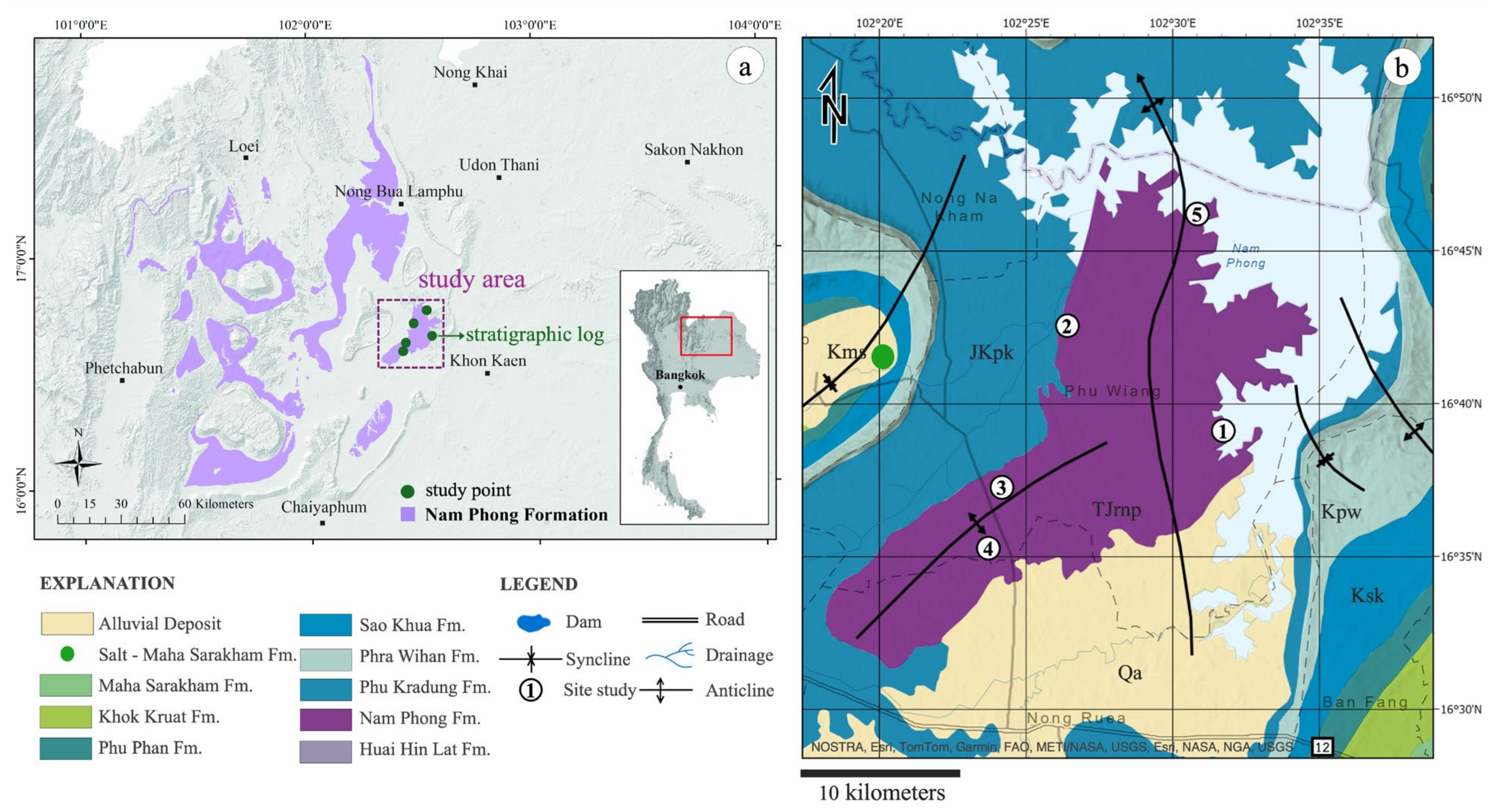
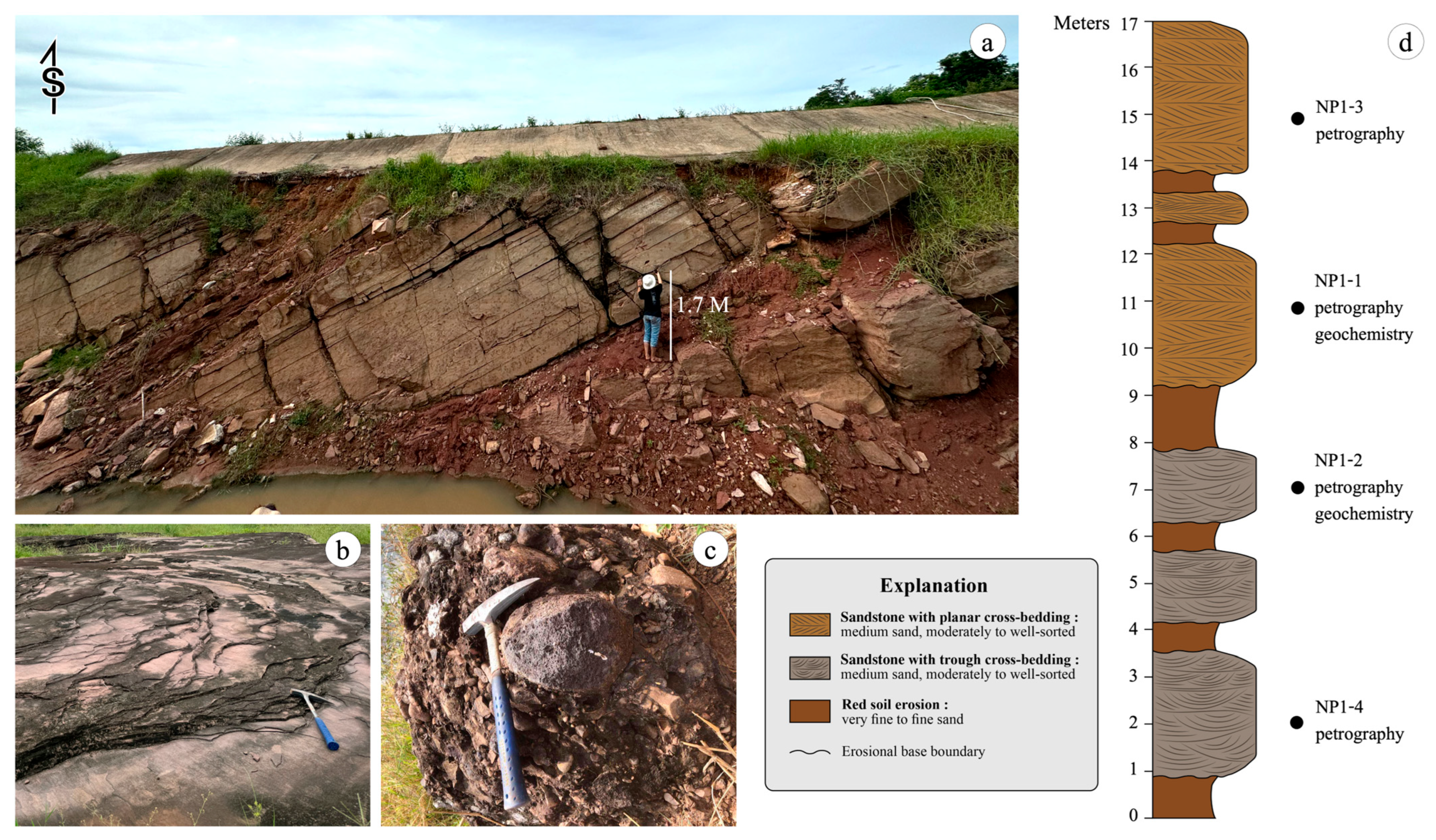
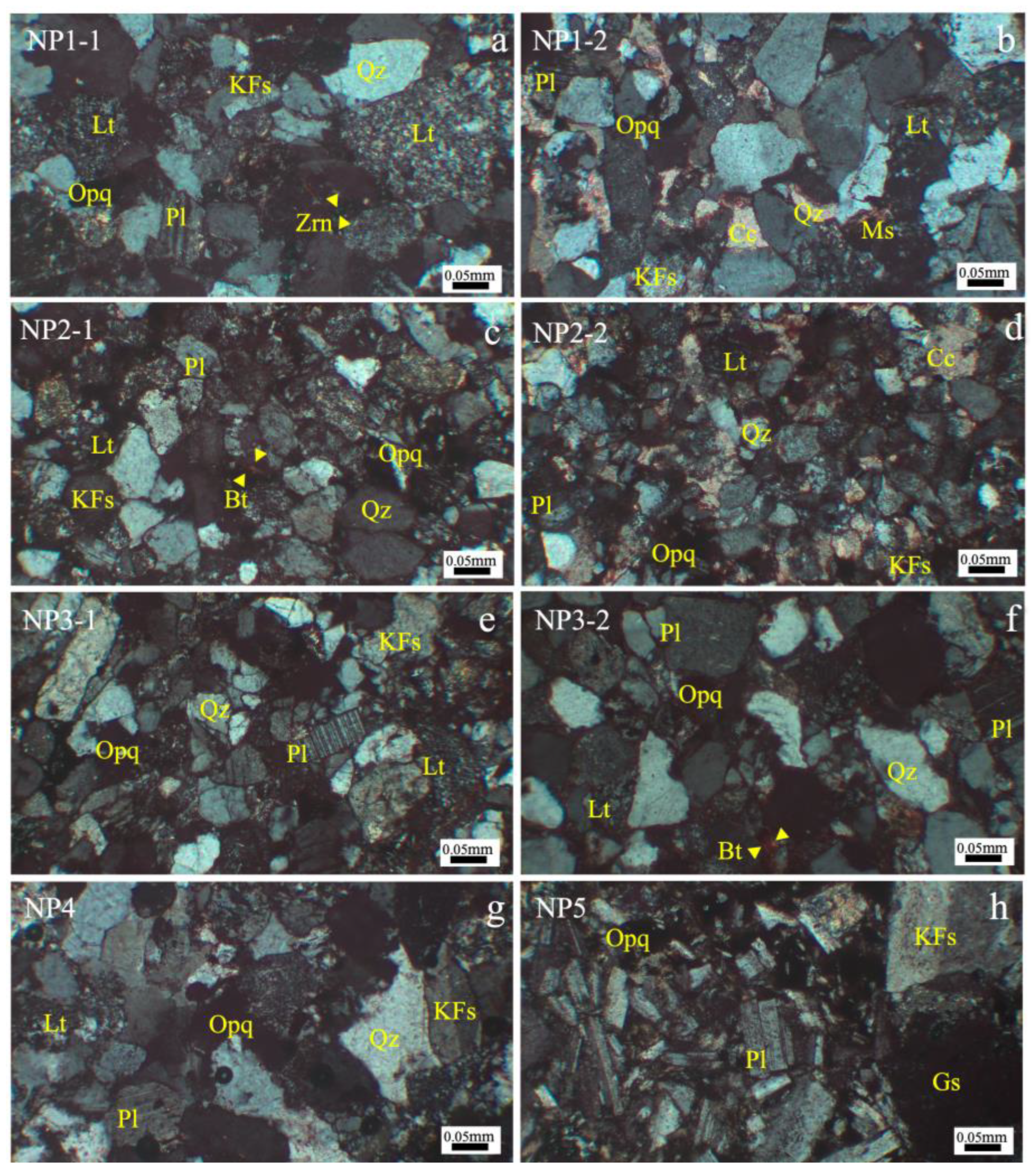
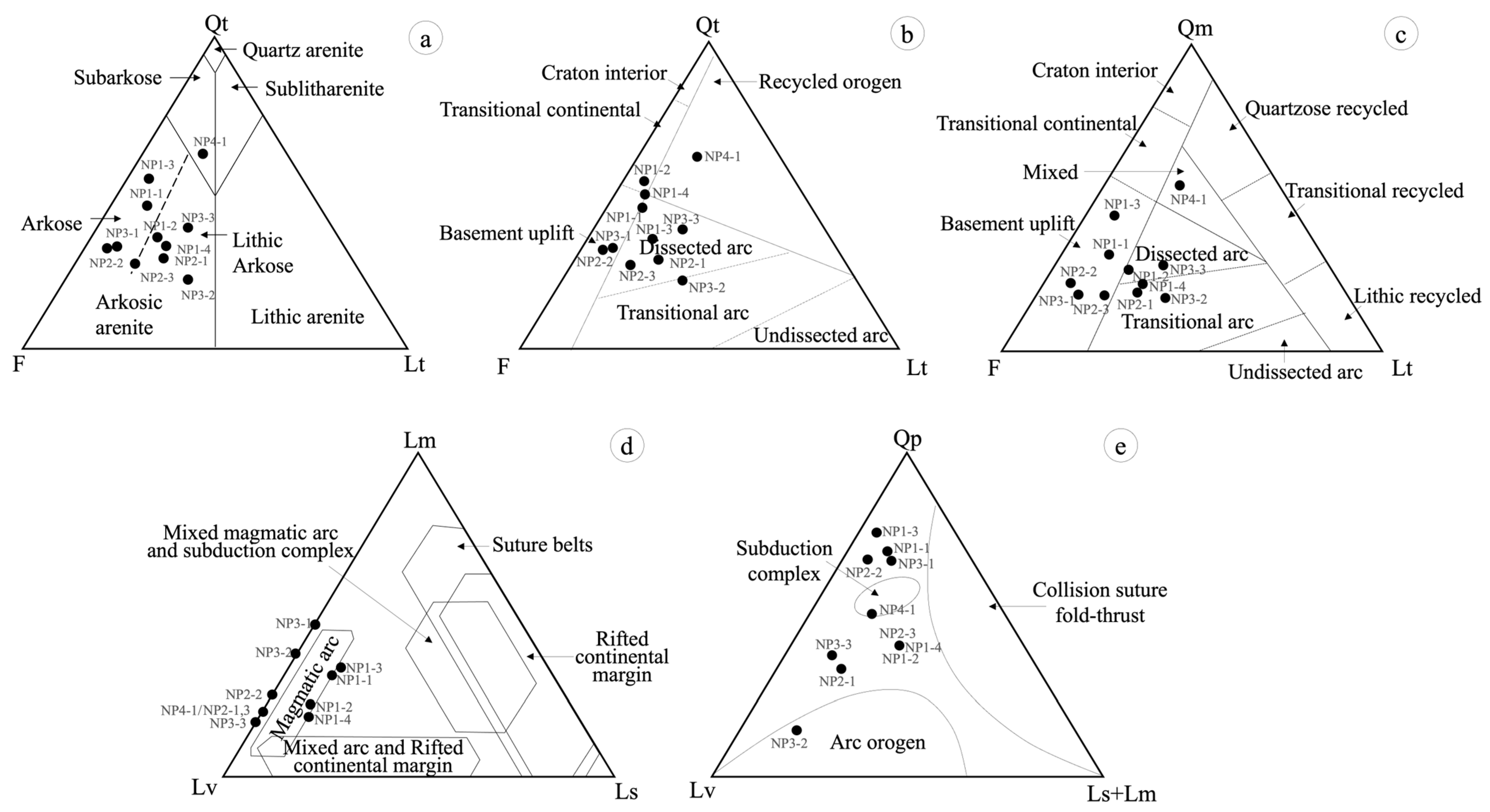

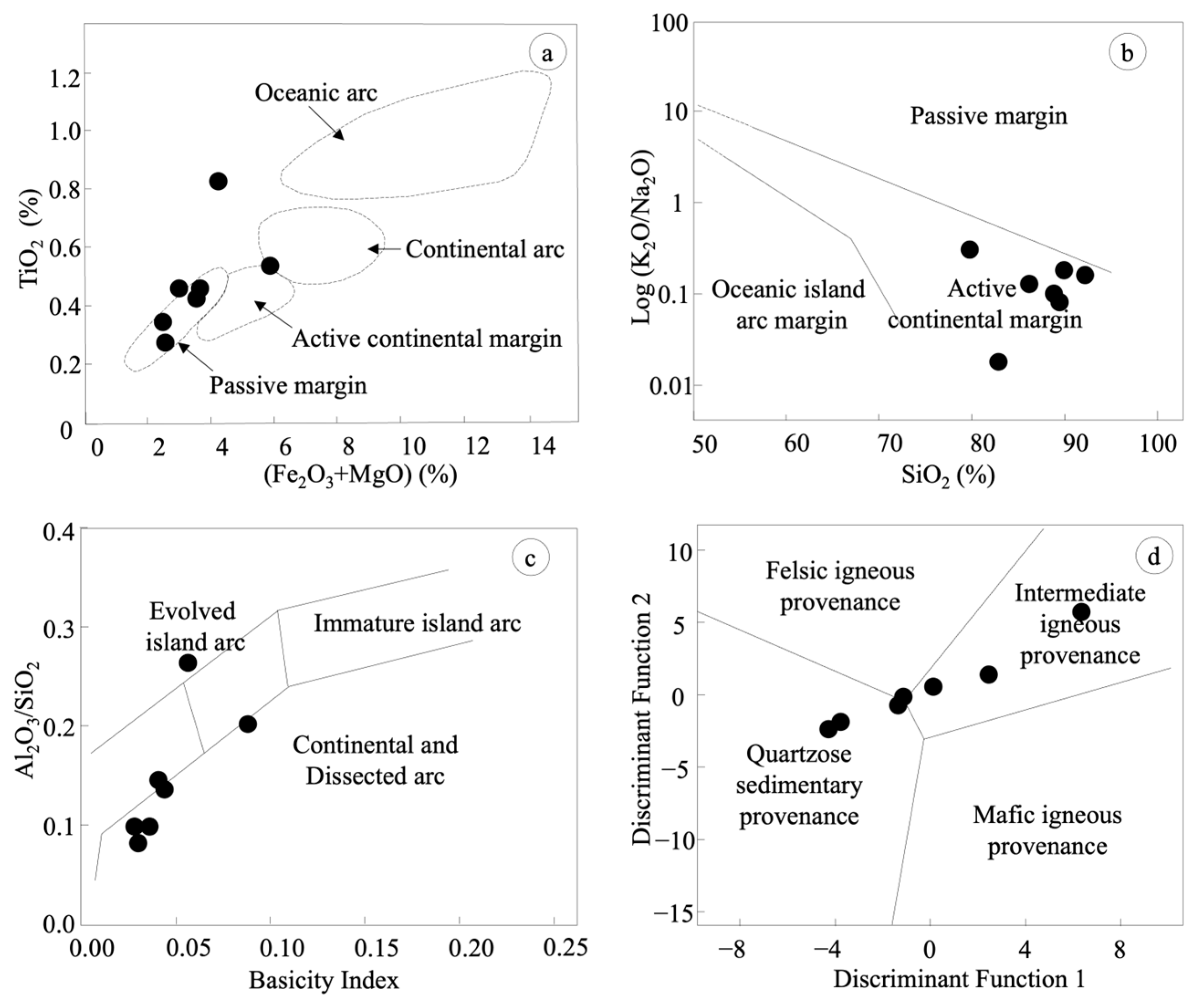


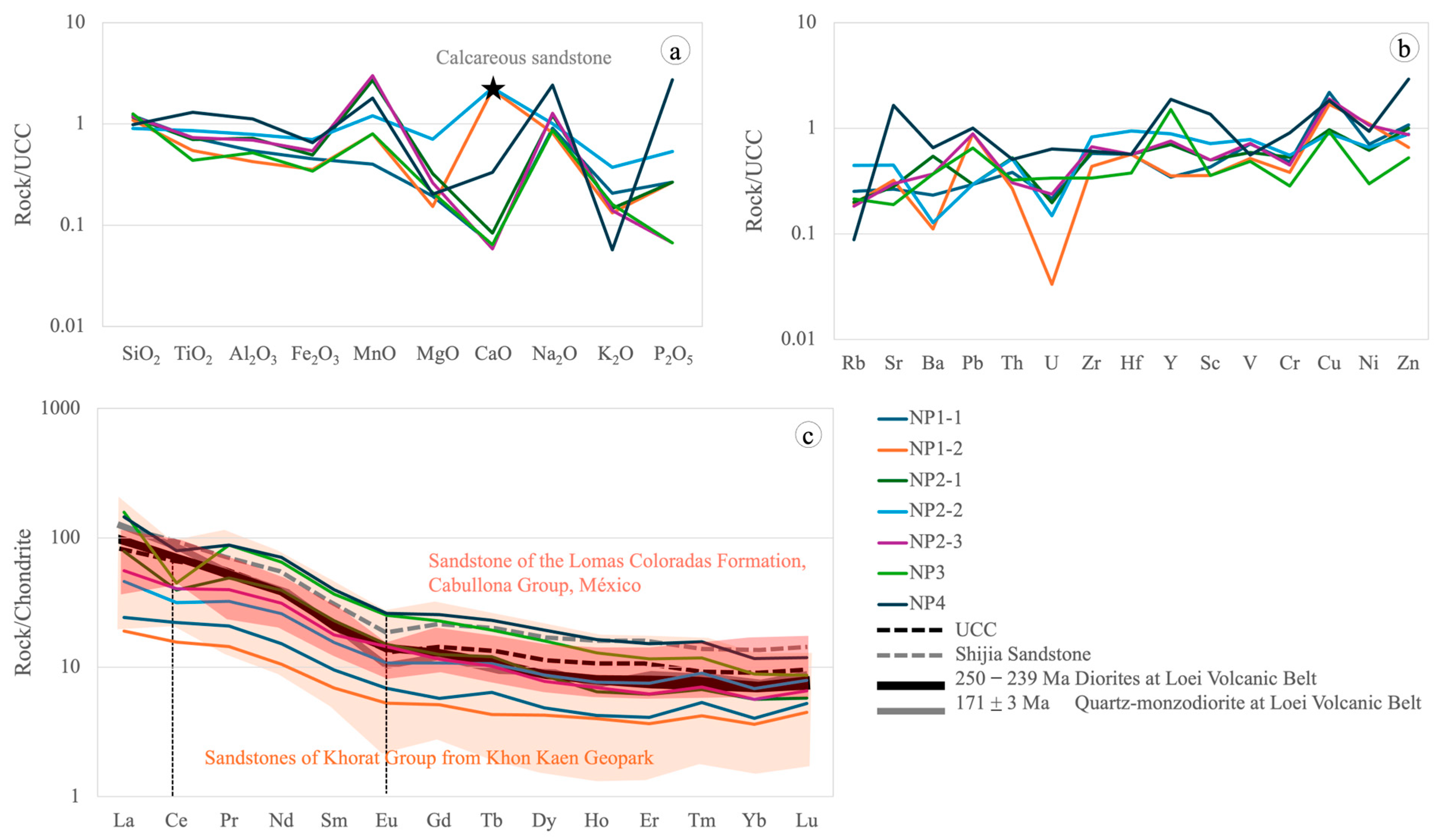
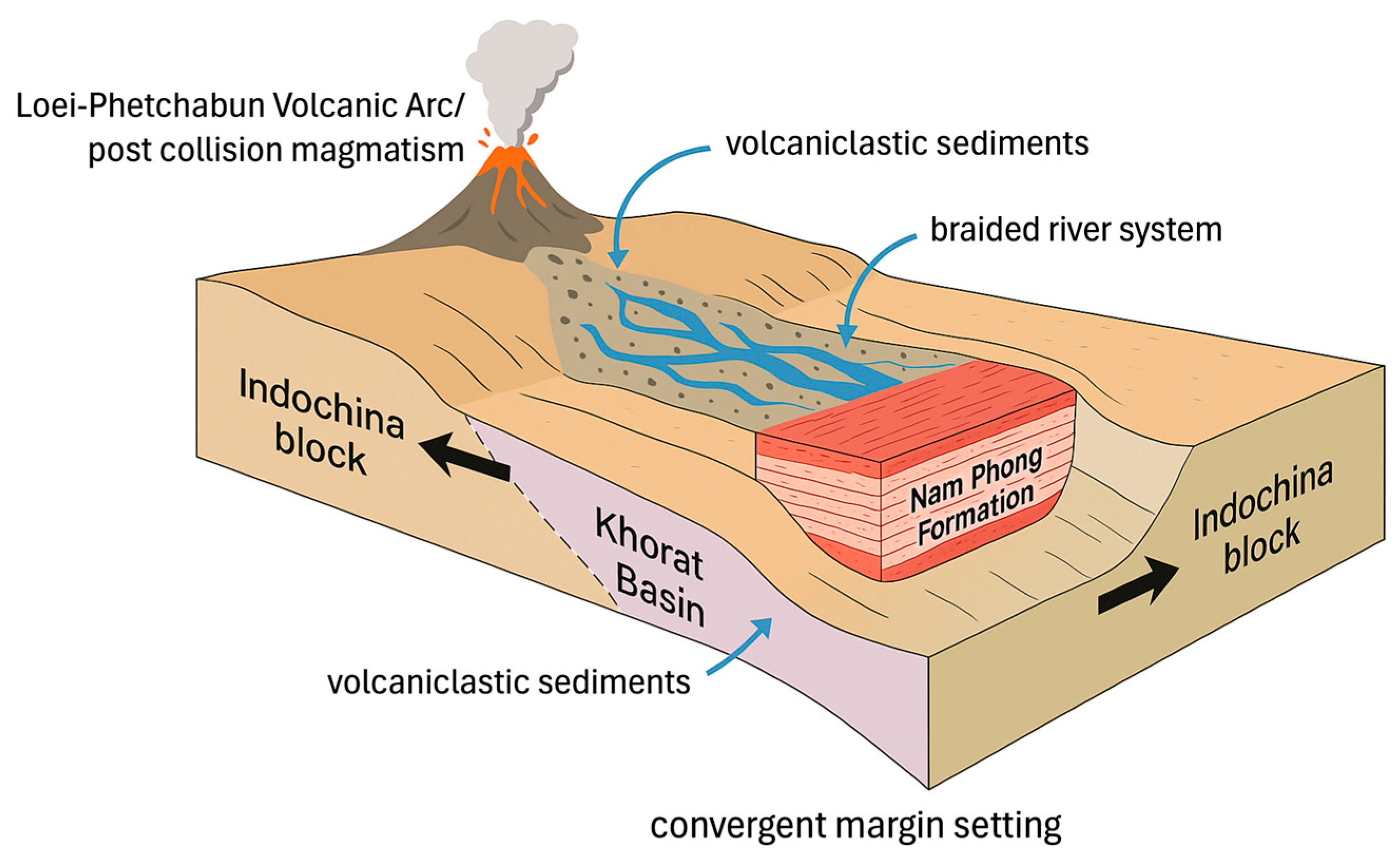
| Site | Location | Sample Code |
|---|---|---|
| NP1 | 16°39′12.4″ N 102°31′47.1″ E | NP1-1, NP1-2, NP1-3, NP1-4 |
| NP2 | 16°42′34.1″ N 102°25′58.9″ E | NP2-1, NP2-2, NP2-3 |
| NP3 | 16°37′14.5″ N 102°23′53.8″ E | NP3 |
| NP4 | 16°35′27.5″ N 102°23′55.9″ E | NP4 |
| NP5 | 16°45′59.2″ N 102°30′45.0″ E | NP5 (volcanic clast) |
| Sample | NP1-1 | NP1-2 | NP2-1 | NP2-2 | NP2-3 | NP3 | NP4 | |
|---|---|---|---|---|---|---|---|---|
| Major oxides (wt%) | MgO | 0.48 | 0.38 | 0.8 | 1.75 | 0.65 | 0.52 | 0.5 |
| Al2O3 | 8.33 | 6.53 | 11.14 | 12.13 | 10.67 | 7.96 | 17.2 | |
| SiO2 | 80.06 | 72.65 | 77.42 | 59.98 | 78.13 | 83.87 | 65.38 | |
| Na2O | 2.98 | 2.66 | 3.99 | 3.28 | 4.17 | 2.83 | 7.91 | |
| K2O | 0.58 | 0.37 | 0.41 | 1.04 | 0.39 | 0.45 | 0.16 | |
| CaO | 0.23 | 7.79 | 0.3 | 8.12 | 0.21 | 0.23 | 1.19 | |
| TiO2 | 0.47 | 0.35 | 0.45 | 0.55 | 0.47 | 0.28 | 0.83 | |
| MnO | 0.04 | 0.08 | 0.27 | 0.12 | 0.3 | 0.08 | 0.18 | |
| Fe2O3t | 2.54 | 1.99 | 2.77 | 3.92 | 3.03 | 1.91 | 3.66 | |
| P2O5 | 0.04 | 0.04 | 0.04 | 0.08 | 0.01 | <0.01 | 0.41 | |
| Trace elements (ppm) | Ba | 146 | 69.8 | 340 | 79.8 | 232 | 232 | 409 |
| Cr | 44 | 35 | 49 | 51 | 41 | 26 | 83 | |
| Cs | 1.3 | 0.9 | 1.1 | 2.5 | 1 | 0.9 | 0.6 | |
| Cu | 61 | 47 | 27 | 25 | 53 | 26 | 51 | |
| Hf | 3 | 3 | 3 | 5 | 3 | 2 | 3 | |
| Li | 0.002 | 0.001 | 0.002 | 0.002 | 0.001 | <0.001 | 0.001 | |
| Nb | 3 | 2 | 3 | 4 | 3 | 1 | 8 | |
| Ni | 33 | 52 | 29 | 31 | 50 | 14 | 44 | |
| Rb | 20.7 | 15.8 | 16.4 | 36.5 | 15 | 17.5 | 7.2 | |
| Pb | 15 | 5 | <5 | <5 | 15 | 11 | 17 | |
| Sc | 6 | <5 | 7 | 10 | 7 | <5 | 19 | |
| Sr | 84.5 | 103 | 89.3 | 143 | 95.4 | 60.6 | 527 | |
| Th | 4 | 2.8 | 5.5 | 5.4 | 3.2 | 3.4 | 5.3 | |
| U | 0.58 | 0.09 | 0.53 | 0.4 | 0.64 | 0.91 | 1.72 | |
| V | 69 | 50 | 57 | 76 | 70 | 47 | 54 | |
| Y | 7.2 | 7.4 | 14.7 | 18.6 | 15.8 | 31.6 | 39.5 | |
| Zr | 111 | 83.8 | 116 | 159 | 129 | 64.8 | 117 | |
| Rare Earth Elements (ppm) | La | 8.9 | 7 | 28.8 | 16.9 | 20.5 | 58 | 53.2 |
| Ce | 21.2 | 15 | 37.8 | 30.3 | 38.8 | 42.9 | 76 | |
| Pr | 2.86 | 1.98 | 6.7 | 4.43 | 5.44 | 12.05 | 12.05 | |
| Nd | 10.8 | 7.5 | 27.9 | 18.4 | 22.2 | 46.2 | 50.3 | |
| Sm | 2.2 | 1.6 | 5.3 | 3.6 | 4.1 | 8.5 | 9.2 | |
| Eu | 0.6 | 0.46 | 1.31 | 0.94 | 1.26 | 2.2 | 2.27 | |
| Gd | 1.76 | 1.57 | 3.84 | 3.31 | 3.53 | 6.99 | 7.82 | |
| Tb | 0.37 | 0.25 | 0.7 | 0.62 | 0.59 | 1.12 | 1.34 | |
| Dy | 1.85 | 1.62 | 3.28 | 3.32 | 2.96 | 6.11 | 7.38 | |
| Ho | 0.36 | 0.34 | 0.55 | 0.65 | 0.59 | 1.1 | 1.39 | |
| Er | 1.02 | 0.91 | 1.54 | 1.87 | 1.55 | 2.89 | 3.79 | |
| Tm | 0.19 | 0.15 | 0.24 | 0.32 | 0.25 | 0.42 | 0.56 | |
| Yb | 1 | 0.9 | 1.4 | 1.7 | 1.4 | 2.2 | 2.9 | |
| Lu | 0.2 | 0.17 | 0.22 | 0.3 | 0.25 | 0.33 | 0.45 |
Disclaimer/Publisher’s Note: The statements, opinions and data contained in all publications are solely those of the individual author(s) and contributor(s) and not of MDPI and/or the editor(s). MDPI and/or the editor(s) disclaim responsibility for any injury to people or property resulting from any ideas, methods, instructions or products referred to in the content. |
© 2025 by the authors. Licensee MDPI, Basel, Switzerland. This article is an open access article distributed under the terms and conditions of the Creative Commons Attribution (CC BY) license (https://creativecommons.org/licenses/by/4.0/).
Share and Cite
Singtuen, V.; Phajuy, B.; Charusiri, P. New Geochemical Insights into Pre-Khorat Paleoenvironments: A Case Study of Triassic–Jurassic Reddish Sedimentary Rocks in Thailand. Geosciences 2025, 15, 324. https://doi.org/10.3390/geosciences15080324
Singtuen V, Phajuy B, Charusiri P. New Geochemical Insights into Pre-Khorat Paleoenvironments: A Case Study of Triassic–Jurassic Reddish Sedimentary Rocks in Thailand. Geosciences. 2025; 15(8):324. https://doi.org/10.3390/geosciences15080324
Chicago/Turabian StyleSingtuen, Vimoltip, Burapha Phajuy, and Punya Charusiri. 2025. "New Geochemical Insights into Pre-Khorat Paleoenvironments: A Case Study of Triassic–Jurassic Reddish Sedimentary Rocks in Thailand" Geosciences 15, no. 8: 324. https://doi.org/10.3390/geosciences15080324
APA StyleSingtuen, V., Phajuy, B., & Charusiri, P. (2025). New Geochemical Insights into Pre-Khorat Paleoenvironments: A Case Study of Triassic–Jurassic Reddish Sedimentary Rocks in Thailand. Geosciences, 15(8), 324. https://doi.org/10.3390/geosciences15080324









